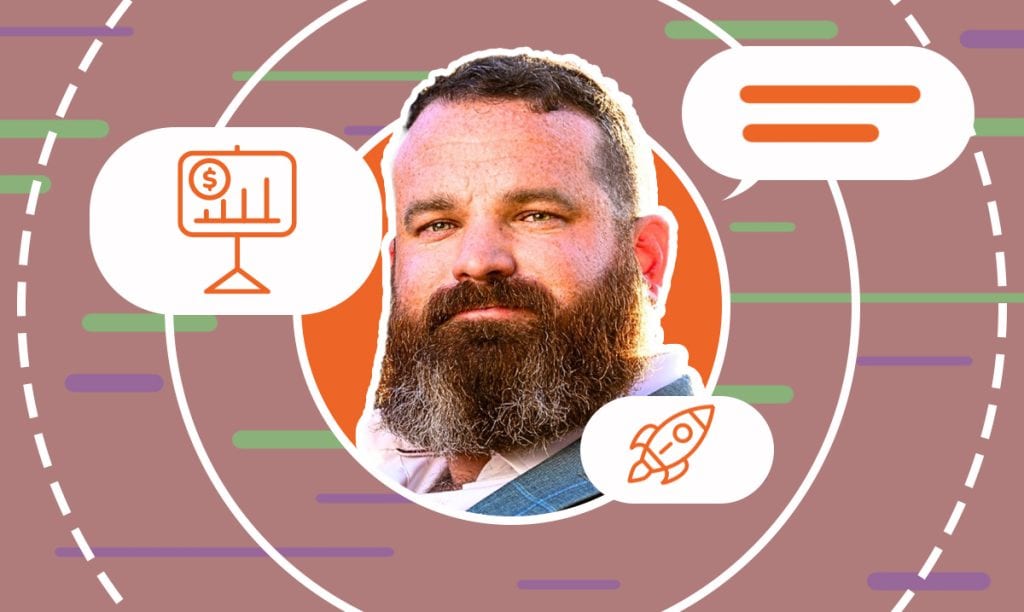Meet Vadim Bozhko, the visionary behind Bozh Studio — a branding and web design business dedicated to helping service-based companies stand out.Fu ...
How Scott Haslam Built a $20M Van Rental Empire
Written by: Carolyn Young
Carolyn Young is a business writer who focuses on entrepreneurial concepts and the business formation. She has over 25 years of experience in business roles, and has authored several entrepreneurship textbooks.
Published on February 19, 2024

Today, we talk with Scott Haslam, the founder of a work-ready van rental company, Kingbee Vans. As their slogan says, they upfit, wrap, and deliver vans all across the US.
Scott sheds light on how the business started in the midst of post-pandemic craziness and how it scaled to north of $20 million in revenue in 2023. Putting an emphasis on sustainability in business practices, Kingbee Vans offers eco-friendly electric vehicles in addition to regular ones, and Kingbee’s sister company, Pollen, provides charging solutions.
But that’s not everything they do in terms of sustainability. To honor their name and spread awareness about the bee extinction, Kingbee Vans partnered with a family-owned Utah honey business, Bees Brothers (they also have a few beehives at their headquarters). So, if you rent one of their work-ready vans, you’ll get a jar of honey to sweeten the deal!
Origin Story and Market Perception
SBS – What inspired you to start Kingbee Vans once, and how did you identify a market need for those services?
Scott – This might be a long-winded story because this wasn’t my first go at business. In 2013 or 2014, I started a commercial vehicle upfitting business, where we took commercial vehicles and added shelving, racks, service bodies, flatbeds, etc. Initially, it began as a CNG and propane conversion business. We partnered with a company in Poland, bringing their product here and converting vehicles. Then gas prices tanked.
We worked with a rental van fleet, doing some of their equipment, and we saw it was a nice niche, good profit margin business. Conversion business is a lot of work and trouble to make a little money, so we pivoted. Any good entrepreneur typically gets into something and realizes they have an idea. If you over-create the idea, it’s difficult to see through, but if you have a broad idea and work your way through the problems right in front of you, you often end up somewhere completely different.
My twin brother and I built this business pretty quickly. The first year’s revenue was maybe $250,000. We got up to about $23 or $24 million in 2023. But at the beginning of 2021, I was looking for new business ideas that I could tack on to what this antiquated industry lacked: a quicker delivery and quicker turnaround time product. Everyone is starting to get used to this “ready now” economy that Amazon’s created for us (especially since 2020), and you didn’t get that in the commercial vehicle industry. If you wanted a commercial vehicle, it took months, sometimes over a year, to get that vehicle and get it to work, so you had to think ahead of how you’re purchasing vehicles before you hire technicians, drivers, or whatever your area is.
Van rental is not new; rental companies would buy a cargo van and rent it as it was — just a box with wheels. We thought that, with our unique experience in a building and upfitting company and a signage company, we could take what we call a work-ready product to the rental market and serve those customers who need a vehicle with a ladder rack, some shelving, or whatever.
With an empty cargo van in rental, you’re just throwing everything on the ground. That’s where our concept came from, and it’s grown pretty quickly. In our first year (2021), we may have purchased 80–100 vehicles. Now, we’re closing in on 2,000 vehicles in the fleet and want to grow a lot. We want to be a 25,000-vehicle fleet at some point. We think that’s possible.
Adapting to Market Shifts
SBS – How did your business adapt to the changes in market demands, especially with the rise of e-commerce and delivery services?
Scott – That’s a good question. This is the story of any business: it’s a little bit of luck and then execution. Quickly touching on COVID, we benefited after it because there were supply constraints with the vehicle market, and we were in a lucky position in a good relationship with Ram, so we could procure vehicles where it would have otherwise been impossible. That got us off the ground, and we’ve continued to benefit from those supply constraints. Now we’re seeing a market correction, so we’re weathering that storm.
As far as how last-mile delivery e-commerce is affecting our business, specifically with cargo vans, there’s a projected 34% year-over-year compounding growth. That means every three years, the demand doubles, and that’s projected for the next 15+ years.
You have to think that whatever Amazon is doing, Walmart has to do it to compete, and so do Target, Costco, and every other big box retailer. Amazon built an online business, then built fulfillment centers, and then built their shipping mechanism to deliver. For Walmart, it’s the opposite. They built fulfillment centers that people would go to, and now they need to build their online e-commerce presence and delivery mechanism because it’s not profitable to deliver through a third party. We’re seeing massive demand in that space, but it can also be pretty volatile for us. Amazon does 75% of its business in six weeks of the year, so their demand for vehicles doubles for six weeks. No rental business survives on six weeks of utilization, so we have to keep these things on the road for as long as possible throughout the year. But we see big opportunities and benefits in what’s happening with last-mile delivery, but it’s also easy to get upside down.
Overcoming Early Challenges
SBS – What challenges did you face in the first couple of years, and how did you overcome them?
Scott – Whenever I talk about building a business, I describe it as marrying capital and sweat. People have an idea, and they think they can just do it. No, you need to understand how to leverage, get money, and put that to work. That’s what scales your business is — you have to have capital. Many people avoid leverage debt. Our business is very capital-intensive because we’re buying tens of millions of dollars in cargo vans, and we have to go then put those to work. In any business, you need to marry those two things, which was a significant challenge because nobody goes to the bank and says, “We need $100 million,” even though they need it. That’s a lot of leverage to take on. The big challenge was where to get the first million or the first $100,000. For our other business, I’d scaled to a much smaller degree of leverage, so I had some experience, but that first $10 million that we had to borrow was very expensive money with a lot of covenants.
SBS – Were you afraid that you wouldn’t be able to make a profit out of it and return it?
Scott – No, and maybe that’s just me being overly confident. I had enough personal experience and understanding of the industry to get comfortable that I could make this happen. But I was personally guaranteed $10 million. If I were still personally guaranteed that, they would still never be able to get it. They’d have to be taking away everything I have for the next ten years. It’s super risky, for sure. But at the end of the day, that’s the game. Just like if you’re investing in the market, you don’t know how things will necessarily turn out. You can get a good understanding of what you’re putting money into. In business, you’re doing the same thing, but you’re investing in yourself, so, really, you’re saying you believe that you can do it if you do everything right and show up every day.
Customization and Quality Assurance
SBS – How does the process of upfitting a van work, and how do you tailor it to different customers’ needs?
Scott – With a cargo van, the manufacturer — whether it’s Ford, Ram, or whoever — wants to produce as many of them as possible and make them as simple as possible (because they’re a low-margin product for them), spit them out. Then, typically, vans are going to another manufacturer, whether an RV upfitter or an upfitter like us.
One thing that can be problematic is everybody thinks they need to have their vehicle built out in a very specific way. Yes, you can do that if you have all the time in the world to wait for that thing to be built in a very specific way. I knew what 95% of these vehicles get: a basic shelving system, a partition to protect the driver, and sometimes some ladder rack.
Rather than try to tailor these to the customer (which would be very difficult for rental because they’re not necessarily paying the rent while we’re building it), we’ve just decided to build standard packages (contractor plus package). We have names for them, and we pre-build them all, and we say we’re taking the van from 40% utility up to 95% utility. It’s so much more valuable just with some shelves and a ladder rack, and our customers can figure out the rest, like the bins or drawers.
For most customers, rental is a band-aid. Maybe their vehicle went down, or they just hired a technician and can’t get them a car for the next few months, so they have to get something in the meantime. With rental, as soon as you can get out of that thing, you will. By making our vans have that much more utility, we can have customers who just put it into their fleet, put it to work, and then move on to their next problem. The next thing you know, 24 months have gone by in rental.
These things stick around a lot longer with the customer as long as we’re priced competitively to other options. That’s the most difficult part about rental: If I have 1,000 vehicles, I want to keep 800 on the road at any time. If I have many of them coming back, I need to refurbish them and move them back out. That’s a whole lot of work to deal with. The ideal customer is one who takes a van and keeps it as long as possible.
SBS – How do you ensure that the quality of your fleet is on the best possible level to maintain customer satisfaction?
Scott – We’ve put a lot of effort into providing good customer service. Communication is key in the automotive or fleet industry.
Your timeline can get muddy in this industry because of when the customer expects the vehicle vs. when they can get it. That’s because you’re dealing with several processes that are independent of each other. First, you have the vehicle’s manufacturing; the time the manufacturer promises to deliver can vary by a few months. Then you have the second stage of manufacturing the equipment you put in and then, often, a third stage of graphics or signage on the vehicle. You might be told you will get this vehicle in six to twelve months. You have a six-month window. In any other situation when you’re buying something, you would never put up with a six-month window.
For us, the idea was to put everything into a single system. After the manufacturing, we bring the vehicles, so the first stage is already done, and we already have inventory. We control the following two manufacturing stages and put them into a central manufacturing system so we can spit out a timeline for that vehicle and be accurate within a few days. I can get that vehicle to a customer nine times out of ten in less than two weeks. You’re going from a six to twelve-month window to a one to two-week window, and many people are willing to pay a little extra for that.
Evolution of Marketing Strategies
SBS – What marketing strategies did you use in the beginning, and how did they change over time? What do you do to attract and retain customers?
Scott – I’d give credit on this one to one of my partners, Matt Williams, our chief marketing officer. He’s built the marketing team, the strategy, branding, and everything, even though he doesn’t have a background in marketing. He came from digital design. I saw him as a creative person, and his strategy was disruptive. If you see how we advertise vs. how anybody else advertised, you will see it’s very different, especially with the content. We’re just trying to stick out a little bit. Rental van ads are probably not the most exciting. I mean, you’re not going to see a Super Bowl ad about cargo van rental, and nobody’s making ads to make you laugh about cargo van rental. But that’s exactly what we’ve done.
We rent long-term to mid-sized to big fleets, so we have a small target market. We could potentially get an opportunity with a few thousand companies and probably ten or less that will be 99% of our rental market. We just wanted to stand out in those circles.
We do lead generation through Google and social media, but most of our opportunity comes through conferences and small publications specific to the space. Our copywriter, Tanner, writes monthly articles for one of those publications.
Branding and Recognition
SBS – Do you think branding is important for people to remember you? Was it difficult to achieve that recognition?
Scott – Yeah, and we’re still working to achieve that. There are many ways to do that. We took the same approach Liquid Death brand of water has. You’ve seen those cans of water, and they stand out. Most other companies in this space have been around for a long time, and that’s why people recognize their names. There’s Enterprise, Penske, or Merchants, and you’ll recognize them just because they’ve been around for 100 years. What do you do to stick out against that? Well, you just need to be ridiculous, in my opinion. When people need a car, they will remember that ridiculous thing they saw.
Our intent has always been to be disruptive. We’re the only cargo van rental company that offers a work-ready product with an upfitted and signed vehicle. That’s disruptive, and our advertising is disruptive. It gets people to give us a shot; when they do, we need to make it the best experience possible. Hopefully, it’s better than the one they had with other rental companies.
Nationwide Logistics Management
SBS – Logistics is extremely important in your business. How do you manage to deliver those vans across the whole US?
Scott – It’s been one of our biggest hurdles, for sure. With traditional vehicles, you can throw on a 7–9 car carrier relatively cheaply and efficiently. Cargo vans are not efficient to ship. They have to go on a flatbed, two or three maybe, so it’s costly. Luckily, the right customer understands that and is willing to pay for it. We don’t want to pay for the shipping, but we have built our own logistics internally and learned to do it very efficiently.
We had a big influx of Amazon demand in September/October, and we shipped out 500 vehicles in the course of a month. That’s two per truck. Historically, we were shipping 50 or 100 cars a month, then 500 vehicles monthly. My little brother is running the logistics. I think what has done well for him is his ADHD because he is on the phone constantly hustling, and we’ve been able to do it as efficiently as anybody can. We’ve also been able to scale it up or down through a really good broker network.
But still, one of the hardest things when competing against Enterprise or Penske is that they’re in every state, so you can go into their building and say you need a van, and we’re over here saying you need to pay us to ship it to you. We think we can figure out how to do it efficiently by utilizing the manufacturer as the ship through, but for now, it’s a hurdle.
Embracing Sustainability
SBS – How do you approach sustainability and eco-friendliness in your services?
Scott – There’s a massive historical disruption in the automotive market, which you can see as problematic. If I’m renting out an electric vehicle, my customer needs some way to charge it. It’s not a consumer EV that they can charge at home. For consumers, it’s a relatively simple problem. For commercial, it’s a very difficult one because we don’t have nearly the network that we need for public charging. So, the charging needs to be private. Do I let my technician take the vehicle home and charge it home? In that case, I need to put in a charger for him. How do we figure that out? What if he quits? Then I spent three grand on a charger. How do we parse out his electricity bill when he’s charging for my company? Or if I’m a big company leasing 100 offices around the country, will I spend tens of millions of dollars in charging infrastructure into buildings that I don’t own? Once we leave, that’s just in the ground. It’s very difficult.
We’ve taken a more holistic approach. About two years ago, we recognized we must start buying EVs (I’ve driven an EV for six years and am a huge fan). We’ve been figuring out how to get in front of it and provide solutions that will cause all the other rental companies to be behind in the next three or four years, so we started a sister company called Pollen. It’s a charging solution provider. We try to set up relationships with existing private charging infrastructure to pair that up with our customers. If we can’t, we just set up charging for customers.
There is no one way to solve that. But by getting in front of that, understanding the problem and the 100 different ways it can be solved, and trying to provide the solution, we can buy these vehicles and feel confident that they’re not just going to sit in a parking lot.
So far, we’ve purchased about 100 EVs (out of 2,000 or so vehicles we’ve purchased in our lifetime), which, as a percentage, is larger than in any other rental company other than maybe Hertz. We are ahead of the curve, but those vehicles have, unfortunately, been sitting in a parking lot for the most part because the charging problem is very real. It’s kind of “a cart before the horse” thing. As an end user, if you want to set up charging, that’s an 18- to 24-month process to get the permit and get everything done with the utility. You still may not be able to get much charging because of headroom problems or because the existing infrastructure doesn’t have the available power. You may end up paying the power company to upgrade transformers and spend hundreds of thousands instead of thousands. Biden administration’s invested a lot into it, but you can’t just redo the infrastructure overnight. We will put a lot of demand in a short period into areas that aren’t built for it. All of that needs to be upgraded over the next 10–15 years, at least.
Industry Trends and Future Outlook
SBS – What other trends do you see in the commercial van and fleet rental industry, and how do you see Kingbee in the future?
Scott – There’s the last mile growth, and it’s the reality that our economy is such that, rather than having a bunch of vehicles go to one place, few go to a lot of places. That’s just a trend that we want to support. Specifically in the US market, asset consolidation is a trend. If you look at real estate, business, or vehicles, they’re getting consolidated into large funds or chunks of capital that then try to put them into service on a use-case basis (you use it as you need it).
Even in the consumer space, as self-driving vehicles become a reality, rather than buying and insuring a vehicle, you’ll have a vehicle that will learn your habits through AI. In that situation, there’s going to be a relatively small number of companies that likely own those assets and monetize them. That’s more in the consumer space, but it’s similar to the fleet space.
If we can provide a product efficiently and quickly over time, we will be the opportunity to jump on. Instead of buying and managing a large fleet, people can come to us and rent vans. We’ve got a broad network and a lot of vehicles, and we can deliver them efficiently and very quickly, so people can hire that technician without trying to figure out what vehicle they’re going to put them in. Consolidation is a very real trend, and consolidation will allow efficiency.
Advice for Aspiring Entrepreneurs
SBS – What advice would you give someone just starting in your or a similar industry?
Scott – The one thing that’s always worked for me was consistency. Every entrepreneur has some big idea or problem they want to solve. They say, “If I solve this, I can make much money doing it.” That may be true, but the real way to be successful is to be consistent and to focus on the problem right in front of you. People get too consumed by the big idea or problem and don’t see the next thing they need to do today to move the needles. They give up quickly because they don’t see the progress. Honestly, it’s just dollar for dollar. It’s an incremental thing. Every once in a while, you hunt that elephant, and you get it, but most of the time, you’re just doing the one little thing that inches it forward, and then you need to be able to continue to feed yourself.
If you wish to explore this business further, feel free to follow Kingbee Vans and Scott on Instagram and check them out on YouTube!
Subscribe to Our Newsletter
and gain insider access to cutting-edge business insights and trends.
Featured Resources

How “Less but Better” Drives Bozh Studio’s Design Edge
Published on April 3, 2025
Read Now

How No Code Map App Delivers Custom Maps Without Coding
Published on April 3, 2025
In this interview, we sit down with Nan Zhou, co-founder of No Code Map App, to discuss how she and her team transformed a trip-planning mapinterfac ...
Read Now

How David Pere Helps Veterans Achieve Financial Freedom
Published on April 3, 2025
In this interview, David Pere, the founder of From Military to Millionaire, shares his inspiring journey from the Marine Corps to financial freedomt ...
Read Now
Comments